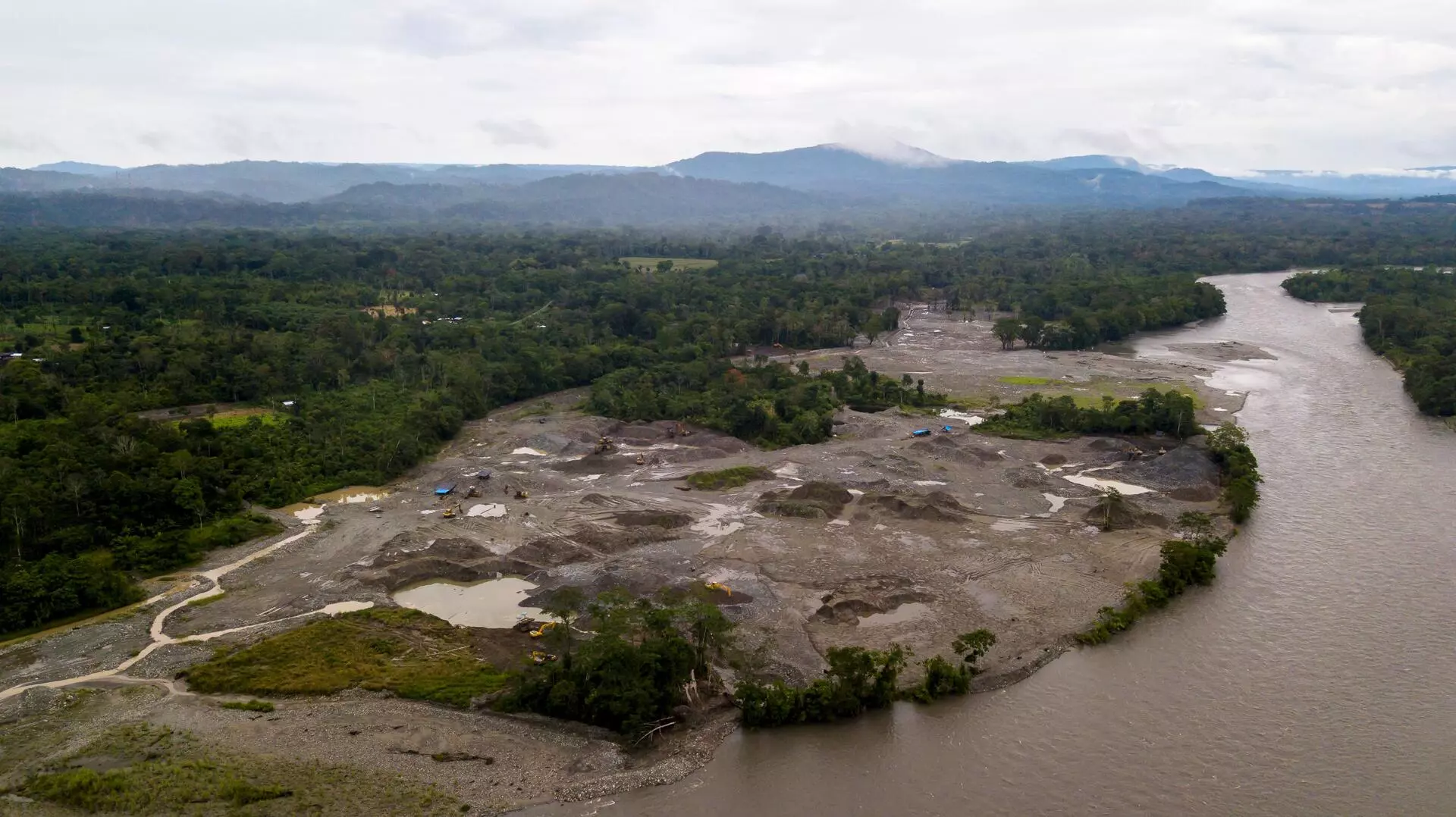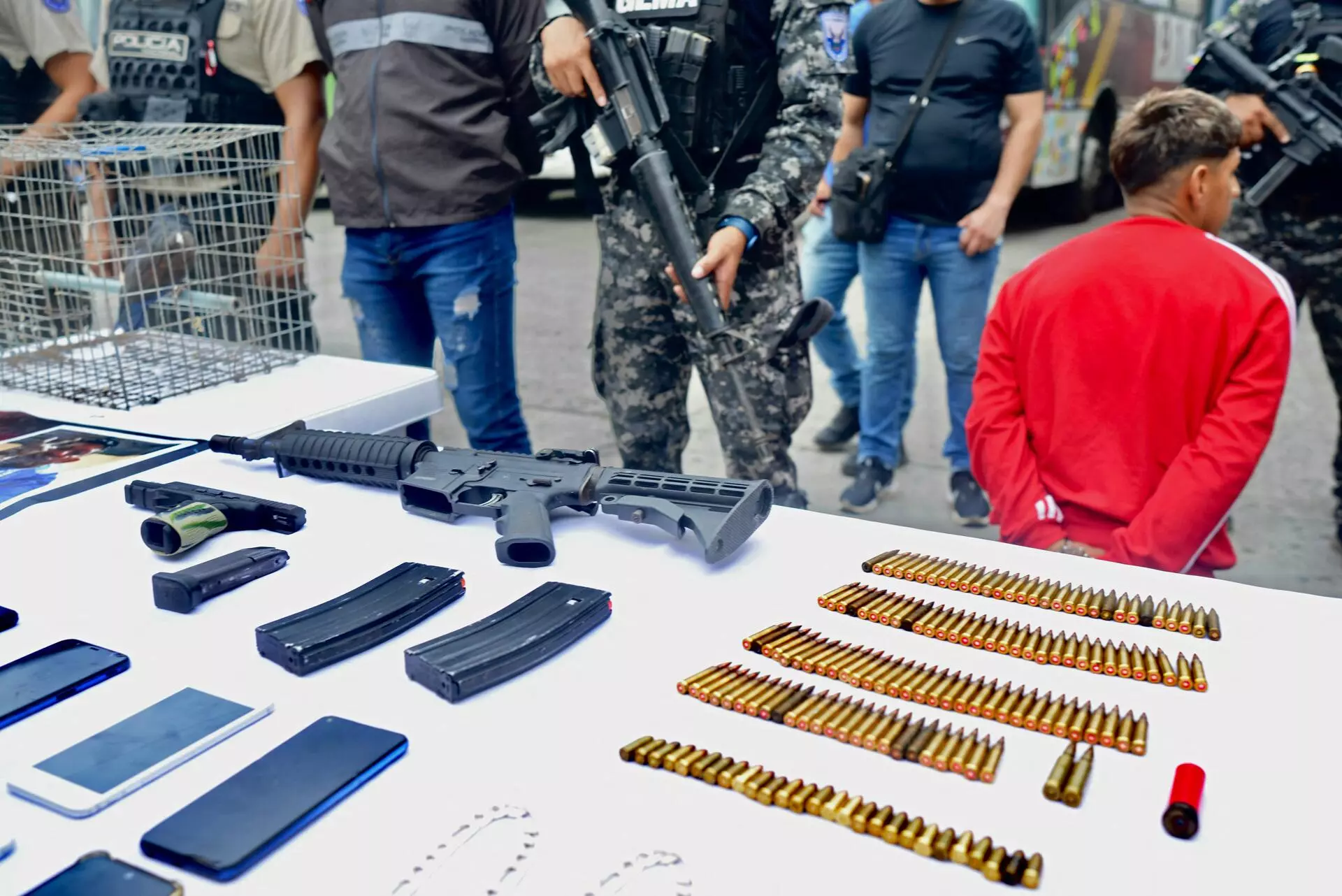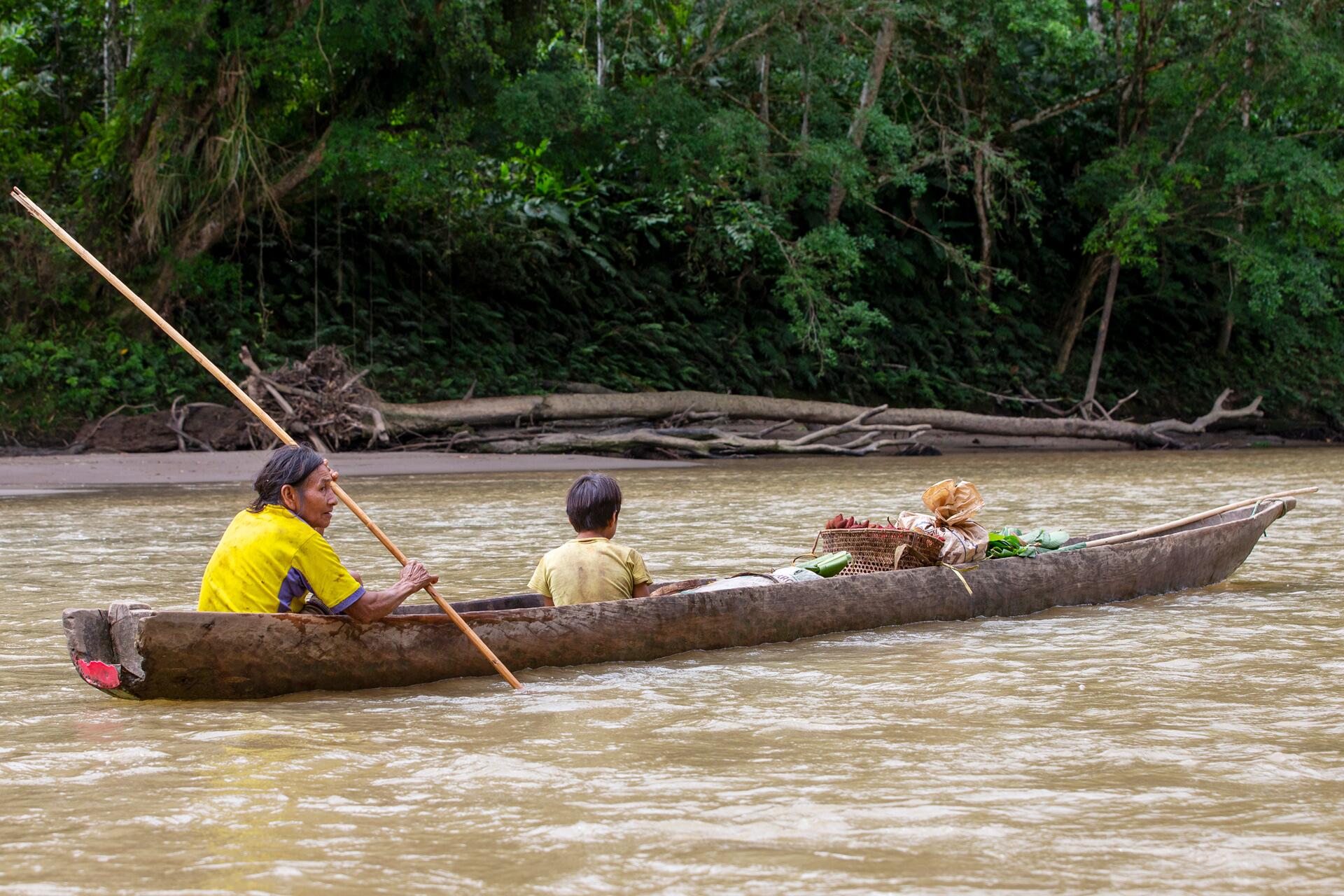Violence in Ecuador increased dramatically in 2023. This growth goes hand in hand with the presence of organized crime groups (OCGs) in the country, criminal gangs linked to drug trafficking, which have expanded their “business” through illegal mining.
Illegal mining —along with arms, explosives, ammunition and human trafficking— affects Amazonian provinces such as Napo and Orellana, not only because of the increase in violence and threats —which have forced Amazonian towns to accept the presence of drug traffickers— but also because of the pollution that mining generates.
“On security issues, the province of Napo already has criminal actions and activities of OCGs, which have been operating for years (…). They’ve taken over our province, Sucumbíos and Orellana,” says Sandra Rueda, assembly member for Napo, who knows much of what is happening, having been delegate of the Ombudsman’s Office in the area from 2019 to 2021.
For several people consulted for this article, there is a very large historical debt owed by the State to the Amazon. This is despite the fact that the oil fields that sustain the economy are located there.
Organized crime groups —which exist in 21 of Ecuador’s 24 provinces— have not only moved in order to make illegal mining an additional source of income. They have also done so to mobilize the economy of Amazonian villages, providing credit and associating with people from different localities to launder their assets. The violence that is experienced in the big cities is also experienced in the Amazonian provinces.
As a result, 2023 was one of the most violent years for Ecuadorians, with approximately 8,009 intentional homicides up to November. An increase of 66% compared to 2022.
In other words, approximately every hour, one person was killed by violence linked to drug trafficking groups.
The presidential decree of January 8, 2024, signed by Daniel Noboa, was a key moment. Members of the Armed Forces and the National Police have taken to the streets and gone into prisons, considered to be the headquarters of the gangs, to confront these groups. This has been viewed with concern by human rights organizations.
But this is only one part of the action of the Armed Forces in the face of organized crime: 118 thousand operations have been carried out, with 9,473 detainees —241 for terrorism, a definition given to them by the State— as well as 160 actions against groups accused of terrorism, and 8 suspected terrorists have been killed. Daniel Noboa’s popularity has soared to 80%, according to the company Comunicaliza.
The shape of illegal mining in the Ecuadorian Amazon
From the air, they look like polka dots of land disrupting the broad green fabric of the Ecuadorian Amazon. These gray, black and brown polygons are filled with liquid into which mercury is poured, to strip the gold from the rock. This gold is the collected at a nearby “ranchitos” —as these camps are known people who come to the different “ranchitos” —as these camps are known— to collect the grams obtained.

Mining in Amazonian provinces has turned into a new source of income for drug traffickers and it is contaminating the rivers that supply communities. Photo: Armando Prado/AFP
According to a report made by the Ministry of Interior, during the government of Guillermo Lasso —called National Strategy against Organized Crime and Serious Crime 2023-2030— it is known that there are criminal gangs in the provinces of Sucumbios —Los Choneros, Tiguerones and Los Lobos-; Morona Santiago and Pastaza —Los Choneros— and Napo, which is run by Los Lobos, a group linked to the Jalisco New Generation Cartel in Mexico. Illegal mining activity has been discovered in the province of Orellana, but it is not known which group is in the territory.
Drug trafficking, illegal mining, arms trafficking, as well as money laundering are among their activities in the Amazon. These groups are stand in for a state that has stopped investing in the public sector. Ecuador comes from a government —that of Guillermo Lasso— which in 2023 was supposed to invest US$1,871 million, but only invested US$779.3 million up to September last year. For example, the Ministry of the Interior, in charge of security, only invested US$31 million of the US$75 million it was supposed to invest, approximately 41% of the budget.
Thanks to the absence of the state, the OCGs fill that vacuum and generate income, albeit at a cost of violence and pollution. Mercury contamination is a major problem in the area, as this metal is released into tributaries or seeps into the rivers once it is absorbed by the soil. This has a knock-on effect as these same rivers supply cities and indigenous communities in the Amazon.
Between 2019 and 2021, Assemblywoman Sandra Rueda, with the support of collectives such as Napo Ama La Vida (Napo Loves Life) and the Federation of Indigenous Organisations of Napa is dedicated to denouncing mining pollution. “Green spaces mean a lot. And not only for nature and biodiversity, but also for the water resources that are important to us,” says the assemblywoman. I am talking about the people in the rural sector, the communities and nationalities, because the water they use comes from the water sources and that is why we are constantly fighting and denouncing. Because not only are they affecting nature and the soil [with mining], they have also not respected the non-intervention in areas where there are inhabitants”. According to the Constitution, intervention in areas inhabited by indigenous communities is not allowed prior to consultation.
Rueda says that mining —legal and illegal— is already affecting urban areas of Napo, and that there are records of the effects on the neighborhoods of the provincial capital. “It is no longer just a jungle issue (…) the effect is linked to urban and populated areas,” she says.
In addition to the absence of the State, what caused criminal groups to increase their activity in these provinces? A source close to the legal dynamics in the area —who did not want to reveal his name for security reasons— explains: “Illegal mining is an activity that allows quick profits for everyone, without State control (…) it is literally work that immediately turns into money, and it is an attractive dynamic for many people”.
Adults and young people who, under the protection of the drug trafficking mafia, dedicate themselves to mining, sell gold at US$45 per gram. Those who buy it —members of the OCGs who have invested money to dig wells, build swimming pools and illegal infrastructure— know they can make about $65 per gram.
According to a source studying the situation, who requested anonymity, “people are dedicated to mining and work like crazy for a fortnight, without rest, to earn 2 to 3 thousand dollars, which is a lot of money in the Amazon”. Compared to activities that might have some kind of ethical rejection, such as arms or timber trafficking, illegal mining creates less resistance, says the source.
Illegal mining and drug trafficking groups: some history
This type of open-pit mining dates back to at least the beginning of the 21st century, when it occurred but on a minimal scale. As of 2015, there was a sudden increase and then the situation worsened rapidly during the lockdowns of the Covid-19 pandemic in 2020.
According to the Organized Crime Characterization Report, presented in mid-2023 by the Ecuadorian Organized Crime Observatory (OECO), the presence of criminal groups from Mexico and Colombia began to increase after 2019. Before that, Ecuador was already part of the market, with local gangs focused on transporting drugs to Central America. But power struggles put an end to this system.

This year, over 118,000 police operations were carried out in Ecuador and around 250 people were arrested for suspected terrorism. Photo: Gerardo Menoscal/AFP
Criminal groups such as Los Lobos, along with two other criminal groups called Los Tiguerones and Los Chone Killers, worked under the orders of Los Choneros. While there was violence, it did not usually affect citizens directly.
Los Choneros, a criminal group that appeared at the end of the 20th century in Chone, a city in the province of Manabí, began with crimes such as extortion, robbery and assaults. By 1998 they were using the port of Manta, in Manabí, to ship drugs to Mexico and the United States, and were the undisputed leaders of the route. Through an inter-gang war that lasted almost 20 years, Los Choneros managed to gain power and lead the rest of the country’s gangs, establishing links with Mexican drug trafficking groups.
The so-called peace ended on December 28, 2020. Jorge Luis Zambrano, alias Rasquiña, leader of Los Choneros, was murdered in a shopping mall in the coastal city of Manta, Manabí. This meant smaller gangs wanted to take center stage.
There is currently no way of quantifying the amount of money that these criminal groups receive from illegal mining in the Amazon. What is known is that the government of Daniel Noboa —through his Minister of Finance, Juan Carlos Vega— has said that the country needs an additional US$1306 million to continue fighting these groups. Money that Ecuador does not have.
Between 2021 and 2022, the Ecuadorian Amazon saw an increase in deforestation of 80%, the highest in the region. From 2017 to February 2023, the Ecuadorian Amazon will have lost 1,660 hectares of rainforest, equivalent to almost five times the size of New York’s Central Park. In provinces such as Sucumbíos, Pastaza, Orellana and Napo, there are hundreds of camps, some of which use heavy machinery to remove the soil and uncover gold. There are so many camps that they are even in national parks, which according to the Constitution are protected zones. In Podocarpus National Park alone —between the provinces of Zamora Chinchipe and Loja— 222 mining camps were discovered in 2023, affecting 25 hectares of the park. Except in oil exploitation areas —to protect the installations—state intervention has been minimal.
What can be done?
The economic magnitude of the problem was revealed in a testimony by the Minister of Energy and Mines, Andrea Arrobo Peña, before the Permanent Specialized Commission on Biodiversity and Natural Resources of the National Assembly on January 17, 2024. He estimated that illegal mining just along the Jatunyacu River, which crosses the community of Yutzupino, in the province of Napo, produced a million grams of gold worth a total of US$60.2 million. That from just one area.
Combating illegal mining in the Ecuadorian Amazon would also mean confronting one of the sources of financing for drug trafficking and reducing pollution. This requires a greater presence of the State and the joint work of the countries that share Amazonian territory. According to the Monitoring of the Andean Amazon Project (MAAP), deforestation in the Amazon areas of Brazil, Bolivia, Peru and Colombia is serious. In addition, a study by InSight Crime and the Igarapé Institute, dated August 2023, states that the presence of criminal groups in Amazonian areas between Colombia, Peru, Brazil and Venezuela, has an impact on the increase of illegal mining and timber trafficking crimes.
According to the study, in Colombia and Venezuela, organized crime —which includes dissident groups of the Revolutionary Armed Forces of Colombia (FARC)— taxes mining activities and businesses that have sprung up around the gold mining area. In the case of Brazil, the most powerful gang, the First Capital Command —Primeiro Comando da Capital, PCC— is already getting into this form of business, with a presence in Yanomami territory, on Brazil’s border with Venezuela. Illegal mining is so prevalent that even companies that have legal mining concessions are appealing to the state for protection.
The study places indigenous communities as the first line of defense against this type of mining, despite threats and attacks. However, in many cases, the communities have had to give in. There are also indigenous communities that have kept criminal gangs at bay, mainly because of the way they are organized, such as the Sarayaku community in Ecuador, which has successfully defended itself from the pressures of the oil and timber industries. According to a source, who asked for anonymity, it is unlikely gangs will find a way into these areas. “The shielding that exists in Sarayaku is the territorial control exercised by the community itself,” he says. In 2020, at the time of the pandemic, the Sarayaku authority prevented loggers from entering: “They cannot divide us and we will not allow it.”
Fact-checker: Plínio Lopes
Proofreader (Portuguese): Valquíria Della Pozza
Portuguese translation: Paulo Migliacci
English translation: Charlie Coombe
Photo Editor: Lela Beltrão
Layout and finishing: Érica Saboya
Editors: Viviane Zandonadi (editorial workflow and copy editing), and Talita Bedinelli (coordination)
Director: Eliane Brum

The Sarayaku people of Ecuador’s Amazon were able to block oil and timber companies from entering their traditional territory. Photo: José Jácome/EFE





